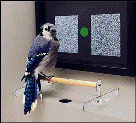Center for Avian Cognition

Avian Cognition Papers
Document Type
Article
Date of this Version
1999
Citation
Published in Animal Behaviour, 1999, 57, F9–F10.
Abstract
We trained Clark’s nutcrackers, Nucifraga columbiana, to search halfway between two landmarks while varying the distance between the landmarks (Kamil & Jones 1997). We found that the birds learned the problem readily and generalized to novel interlandmark distances within the range of distances used during training. Unlike some other studies in which responses to proportional distance were obtained (e.g. O’Keefe & Burgess 1996; Tommasi et al. 1997), the nutcrackers showed very precise search and maintained this precision during the transfer test. The distributions of digging locations around the central position were concentrated within ±1–2 cm of the central location for both training and test interlandmark distances (see Figure 2 in Kamil & Jones 1997). We reached two conclusions based on this rather precise transfer: (1) the birds used the relationship between the landmarks (rather than goal–landmark relationships) to solve the problem; and (2) the birds had learned a general principle which they could then apply to new interlandmark distances.
Biegler et al. (1999) propose a model that agrees with our first conclusion but suggests that we were premature in the second. According to their model the nutcrackers learned specific vectors for each interlandmark distance used during training. Then, when faced with a novel interlandmark distance, the birds retrieved the vectors associated with the two interlandmark training distances closest to the novel test distance and averaged the vectors. This would produce search at the halfway point. This process would require use of interlandmark distance, part of the geometric relationship between the landmarks. It would also account for the data we reported without appeal to any general principle of halfway. However, we think there are at least two features of our original data that argue against this model.
Included in
Animal Studies Commons, Behavior and Ethology Commons, Cognition and Perception Commons, Forest Sciences Commons, Ornithology Commons, Other Psychology Commons


Comments
Copyright © 1999 The Association for the Study of Animal Behaviour. Used by permission.